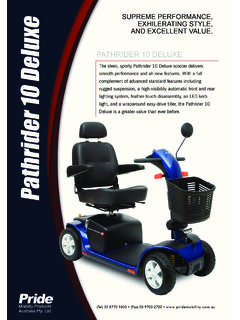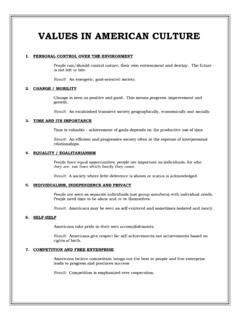Transcription of DISABILITY RIGHTS HISTORY TIMELINE
1 pride : A Curriculum / High School Unit 3 Student Handout 71 DISABILITY RIGHTS HISTORY TIMELINE 1817 - The American School for the Deaf is founded in Hartford, Connecticut. This is the first school for disabled children in the Western Hemisphere. 1832 - The Perkins School for the Blind in Boston admits its first two students, the sisters Sophia and Abbey Carter. 1841 - Dorothea Dix begins her work on behalf of people with disabilities incarcerated in jails and poorhouses. 1848 - The Perkins Institution in Boston was founded by Samuel Gridley Howe. It was the first residential institution for people with mental retardation. Over the next century, hundreds of thousands of developmentally disabled children and adults were be institutionalized, many for their entire lives.
2 1854 - The New England Gallaudet Association of the Deaf is founded in Montpelier, Vermont. 1864 - The Columbia Institution for the Deaf and Dumb and Blind became the first college in the world established for people with disabilities. The institution would eventually be renamed Gallaudet College, and then Gallaudet University. 1869 - The first wheelchair patent is registered with the Patent Office. 1878 - Joel W. Smith presented Modified Braille to the American Association of Instructors of the Blind. The association rejected his system, continuing to endorse instead New York Point, which blind readers complain is more difficult to read and write. What follows was a War of the Dots in which blind advocates for the most part prefer Modified Braille, while sighted teachers and administrators, who control funds for transcribing, prefer New York Point.
3 1880 - The International Congress of Educators of the Deaf, at a conference in Milan, Italy, calls for the suppression of sign languages and the firing of all deaf teachers at schools for the deaf. Deaf advocates viewed this as an attack on deaf culture. The National Convention of Deaf Mutes meets in Cincinnati, Ohio, the nucleus of what will become the National Association of the Deaf (NAD). The first major issue taken on by the NAD is oralism and the suppression of American Sign Language. pride : A Curriculum / High School Unit 3 Student Handout 721883 - Eugenics is a term that was coined by Sir Francis Galton in his book Essays in Eugenics. The eugenics movement in the United States resulted in the passage of laws that prevented people with disabilities from moving to this country, marrying, or having children.
4 Laws in many states resulted in the institutionalization and forced sterilization of disabled people, including children. 1909 - A Mind that Found Itself by Clifford Beers exposed conditions inside state and private mental institutions. The New York Public School System adopts American Braille for use in its classes for blind children, after public hearings where blind advocates called for abandoning New York Point. The first folding wheelchairs are introduced for people with mobility disabilities. 1912 - The Kadikak Family by Henry H. Goddard was a best selling book that suggested a link between DISABILITY and immorality and alleged that both were tied to genetics. The Threat of the Feeble Minded was a popular pamphlet.
5 Both documents advanced the agenda of the eugenics movement and increased the climate of hysteria that led to massive human RIGHTS abuses of people with disabilities. 1918 - The Smith-Sear Veterans Vocational Rehabilitation Act establishes a federal vocational rehabilitation for disabled soldiers. 1920 - The Fess-Smith Civilian Vocational Rehabilitation Act is passed, creating a vocational rehabilitation program for disabled civilians. 1927 - The Supreme Court, in Buck v. Bell, ruled that the forced sterilization of people with disabilities was not a violation of their constitutional RIGHTS . Justice Oliver Wendell Holmes compared sterilization to vaccination. The decision removed the last restraints for eugenicists. By the 1970s, over 60,000 people with disabilities were sterilized in the 1929 - Seeing Eye establishes the first dog guide school for blind people in the United States.
6 1933 - Franklin Delano Roosevelt, the first person with a significant DISABILITY to be elected as a head of government, was sworn into office as president of the United States. 1935 - The League of the Physically Handicapped was formed in New York City. The group organized sit-ins, picket lines, and demonstrations to protest employment discrimination against people with disabilities by the Works pride : A Curriculum / High School Unit 3 Student Handout 73 Progress Administration (WPA). This advocacy eventually led to the creation of 1500 jobs for people with disabilities in New York City. The Man Unknown by Nobel Prize winning Dr. Alexis Carrel suggested the euthanasia (killing) of criminals and the mentally ill by using institutions equipped with suitable gasses.
7 1937 - Herbert A. Everest and Harry C. Jennings patented a design for a folding wheelchair with an X-frame that could be packed into a car trunk. They found Everest & Jennings (E & J), which eventually became the largest manufacturer of wheelchair in the United States. 1938 - Passage of the Fair Labor Standards Act led to an enormous increase in the number of sheltered workshop program for blind workers. Meant to provide training and job opportunities for blind and visually disabled workers, employment practices at workshops often led to exploitation of workers at sub-minimum wages in poor conditions. 1939 - World War II began. Hitler ordered widespread mercy killing of the sick and disabled. The Nazi euthanasia program (code name Aktion T4) was implemented to eliminate life unworthy of life.
8 1940 - The American Federation of the Physically Handicapped was the first cross- DISABILITY national political organization to urge an end to job discrimination, call for a National Employ the Physically Handicapped Week, and propose other legislative initiatives. 1940 1944 908 patients were transferred from an institution for retarded and chronically ill patients in Schoenbrunn, Germany to the euthanasia center at Eglfing-Haar to be gassed. A monument to the victims stands in the courtyard at Schoenbrunn. 1941 - Hitler suspended the Aktion T4 program that killed nearly 100,000 people. Euthanasia continued through the use of drugs and starvation instead of gassing. 1945 - President Harry Truman signed PL-176 creating an annual National Employ the Handicapped Week.
9 1946 - The National Mental Health Foundation was founded by World War II conscientious objectors who served as attendants at state mental institutions rather than serve in the war. It worked to expose the abusive conditions at these facilities and became an early impetus for advocating for people with disabilities to live in community settings instead of institutions (deinstitutionalization). pride : A Curriculum / High School Unit 3 Student Handout 74 1947 -The first meeting of the Presidents Committee on National Employ the Physically Handicapped Week was held in Washington, Its publicity campaigns, coordinated by state and local committees, emphasized the competence of people with disabilities. Movie trailers, billboards, and radio and television ads were used to convince the public that its good business to hire the handicapped.
10 1948 - The disabled students program at the University of Illinois at Galesburg was officially established. The program moved to the campus at Urbana-Champaign where it became a prototype for disabled student programs and independent living centers across the country. We Are Not Alone (WANA), a mental patients self-help group, was organized at the Rockland State Hospital in New York City. 1949 - The first Annual Wheelchair Basketball Tournament was held in Galesburg, Illinois. Wheelchair basketball, and other sports, became an important part of DISABILITY lifestyle and culture over the next several decades. 1951 - Howard Rusk opened the Institute of Rehabilitation Medicine at New York University Medical Center. Staff at the Institute, including people with disabilities, began work on such innovations as electric typewriters, mouth sticks, and improved prosthetics for use by people with disabilities.






